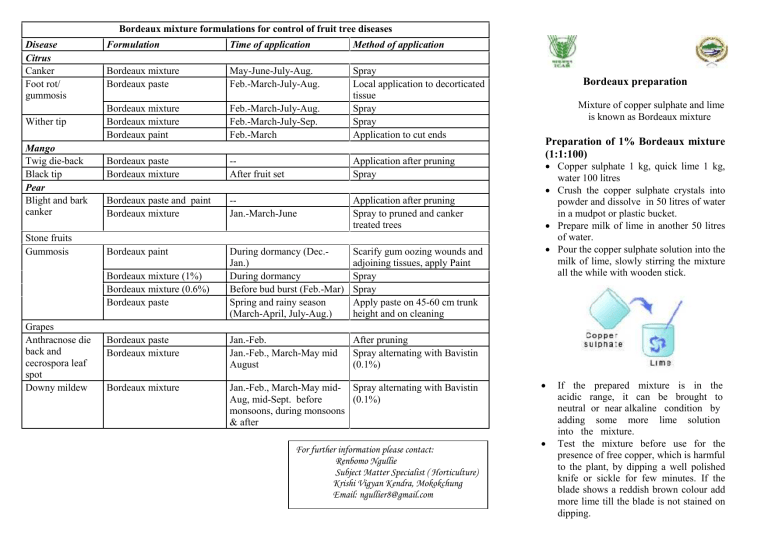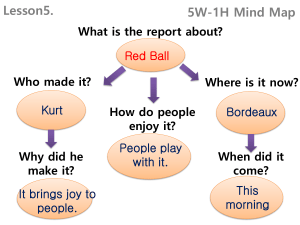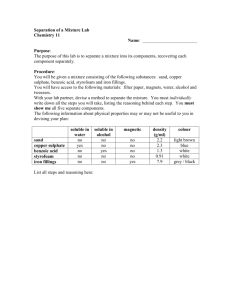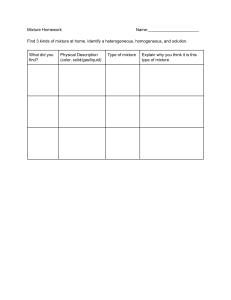
Bordeaux mixture formulations for control of fruit tree diseases Disease Citrus Canker Foot rot/ gummosis Wither tip Mango Twig die-back Black tip Pear Blight and bark canker Stone fruits Gummosis Formulation Time of application Method of application Bordeaux mixture Bordeaux paste May-June-July-Aug. Feb.-March-July-Aug. Bordeaux mixture Bordeaux mixture Bordeaux paint Feb.-March-July-Aug. Feb.-March-July-Sep. Feb.-March Spray Local application to decorticated tissue Spray Spray Application to cut ends Bordeaux paste Bordeaux mixture -After fruit set Application after pruning Spray Bordeaux paste and paint Bordeaux mixture -Jan.-March-June Application after pruning Spray to pruned and canker treated trees Bordeaux paint During dormancy (Dec.Jan.) During dormancy Before bud burst (Feb.-Mar) Spring and rainy season (March-April, July-Aug.) Scarify gum oozing wounds and adjoining tissues, apply Paint Spray Spray Apply paste on 45-60 cm trunk height and on cleaning Bordeaux paste Bordeaux mixture Jan.-Feb. Jan.-Feb., March-May mid August After pruning Spray alternating with Bavistin (0.1%) Bordeaux mixture Jan.-Feb., March-May mid- Spray alternating with Bavistin Aug, mid-Sept. before (0.1%) monsoons, during monsoons & after Bordeaux mixture (1%) Bordeaux mixture (0.6%) Bordeaux paste Grapes Anthracnose die back and cecrospora leaf spot Downy mildew For further information please contact: Renbomo Ngullie Subject Matter Specialist ( Horticulture) Krishi Vigyan Kendra, Mokokchung Email: ngullier8@gmail.com Bordeaux preparation Mixture of copper sulphate and lime is known as Bordeaux mixture Preparation of 1% Bordeaux mixture (1:1:100) Copper sulphate 1 kg, quick lime 1 kg, water 100 litres Crush the copper sulphate crystals into powder and dissolve in 50 litres of water in a mudpot or plastic bucket. Prepare milk of lime in another 50 litres of water. Pour the copper sulphate solution into the milk of lime, slowly stirring the mixture all the while with wooden stick. If the prepared mixture is in the acidic range, it can be brought to neutral or near alkaline condition by adding some more lime solution into the mixture. Test the mixture before use for the presence of free copper, which is harmful to the plant, by dipping a well polished knife or sickle for few minutes. If the blade shows a reddish brown colour add more lime till the blade is not stained on dipping. Strain the prepared Bordeaux mixture through a cloth/strainer before spraying. 100 litres can be used for spraying 50 trees @ 2 litre per tree. Bordeaux paste Pruning is a regular horticultural operation used of removing dead wood, diseased parts and to give shape to the fruit tree. It is undertaken annually during dormant period. The cut ends created during pruning need to be protected against infection by different pathogens, by sealing with suitable fungicide pastes. The Bordeaux paste is the most effective wound dressing material for this purpose. The fine layer formed on the cut ends kills the pathogen from subsequent invasion and results in rapid healing of the wounds. Preparation of paste (1:1:10) Copper sulphate 1 kg, quick lime 1 kg, water 10 litres Crush the copper sulphate crystals into powder and dissolve in 5 litres of water in a mudpot or plastic bucket. Prepare milk of lime in another 5 litres of water. Pour the copper sulphate solution into the milk of lime, slowly stirring the mixture all the while with wooden stick. Test the mixture before use for the presence of free copper, which is harmful to the plant, by dipping a polished knife in it. If the blade shows a reddish brown colour add more lime till the blade is not stained on dipping. Apply the paste on cut ends of trees with a brush gall or hairy roots from the stems of infected plants during dormant period. It is a suitable recommendation in areas or seasons which receive heavy downpour. It protects the treated part of the host against water for longer period, thus ensuring rapid healing of wounds. Preparation of paint Copper sulphate 1 kg, quick lime 2 kg, boiled linseed oil 3 litres Heat the copper sulphate crystals on an iron sheet or in frying pan till it crumbles into a white amorphous form. Ground the heated crystals into a fine powder. Boil the linseed oil and allow it to cool Mix the copper sulphate powder thoroughly with lime dust and homogenised in 3 litres of cooled oil to make a thick paste Apply the paint to the plant parts with the help of a brush up to 1m from the base of the tree. Apply the paint during Feb-March, Sep Oct, and Dec-Jan to protect the plant from soil borne pathogen. Store the paste in a glass jar or other suitable non-metallic vessel for future use Bordeaux paint. Bordeaux paint is applied for curing the deep and deformed wounds caused by cankers, gummosis, collar rot/root rot and to wounds resulting from surgical removal of crown Apply at the base of the tree at 1 m above ground level. Some do’s and don’ts Use the Bordeaux mixture soon after preparation. If should not be stored for further use. Do not use metallic containers for preparing copper sulphate solution and lime suspension. Use wooden stick for stirring to get a homogenous mixture. Never use metallic stick. Do not use the Bordeaux mixture in combination with any other chemical or pesticide e.g. in citrus, zinc sulphate spray should be given keeping a gap of at least one week from that of the Bordeaux mixture. To avoid choking of the nozzle, it is advisable to strain the Bordeaux mixture through a cloth or a sieve before putting it into the spray tank. The Bordeaux mixture tends to sediment easily. Therefore, stirring while using is desirable. It is not advisable to spray the Bordeaux mixture on fruit-laden trees as the spray may inflict russetting especially on apple and pear. In exceptionally hot days, when the plants are showing signs of temporary wilting or when it is raining, the Bordeaux mixture should not be sprayed, particularly on newly emerged tender foliage. After carrying out spray operations, the appliances should be thoroughly washed with plenty of water to remove any copper deposits. The left over Bordeaux mixture should not be dumped in the field as this may prove toxic to the subsequent sowings.




